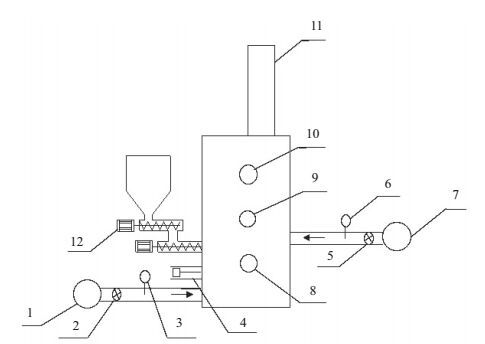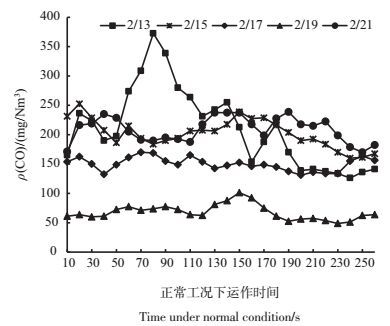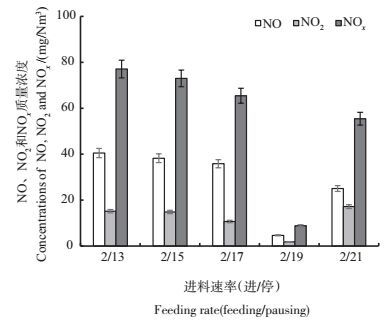| 进料速率对生物质颗粒燃烧烟气排放特性的影响 |
2. 浙江商业职业技术学院应用工程学院,杭州 310053
2. Applied Engineering College, Zhejiang Business College, Hangzhou 310053, China
生物质颗粒成型燃料是以木屑、秸秆等农林废弃物为原料,利用机械设备压缩成圆柱颗粒状且质地坚实的成型物,可作为工业锅炉、炊事炉灶、民用取暖炉和农业加温的燃料,具有体积小、能量密度大、便于运输和贮藏等优点。随着我国可再生能源开发利用与节能减排政策的实施,生物质颗粒燃料的生产和销售已进入商业化运营阶段,大规模使用生物质颗粒燃料方兴未艾,有些地区甚至出现颗粒燃料供不应求的局面。
近年来,生物质颗粒燃料燃烧器在小型热水锅炉、农业温室和养殖设施的加温热风炉、家用取暖炉等领域得到了广泛应用。然而,目前大部分燃烧器的工况参数设置存在较多不合理之处,导致在使用过程中烟气污染物排放量大,制约了其推广应用。王月乔等[1]在生物质颗粒燃料适应性研究中发现,燃烧器颗粒物排放通常在98 mg/Nm3左右,烟气格林曼黑度为Ⅱ级。张学敏等[2]研究在不同进料方式下燃烧器在燃烧过程中的排放特性发现,烟气中CO含量通常在800 mg/Nm3左右,NOx含量在134 mg/Nm3左右。可见,现存的大多数颗粒燃烧器在使用过程中烟尘浓度和CO排放值偏高,因此,有必要研究燃烧器工况参数与污染物排放量之间的关系,以便为颗粒燃料的清洁燃烧及达标排放提供科学依据。
进料速率是颗粒燃烧器的重要工况参数之一,与燃烧器热负荷和污染物排放量直接相关。燃烧器经优化设计并加工定型后,燃烧室和进风量配置等结构参数就已被确定,因此,进料速率的合理调控成为关键因素。进料速率过大会导致供氧不足,烟气中CO、NOx等污染物排放量高,污染环境[3]。进料速率过小既达不到需要的热负荷,又因供入空气量过多,导致可燃气体在炉膛中停留时间过短,引起不完全燃烧,同样会增加污染物排放[4]。DIAS等[5]在研究进料速率与CO含量的关系时发现,在过量空气系数不变的情况下,当进料速率从5 kg/h逐渐增加到6 kg/h时,烟气中CO含量逐渐降低,随着进料速率的继续增加CO含量又开始升高。另外,有学者研究发现,在进料速率增加的初始阶段通入炉膛内的空气未被完全利用,随着进料速率的继续增加使其充分利用,CO含量开始降低,当进料速率超过某个临界值后,炉膛内出现了缺氧燃烧,CO含量再次升高[6-7]。综上,现有研究主要集中在进料速率对CO排放的影响,而进料速率对NOx排放的影响却鲜见报道,且烟气中污染物含量随燃烧器运行时间的波动特征尚不清楚。因此,本文以一种小型热水锅炉配套的生物质颗粒燃烧器为对象,研究颗粒燃料进料速率对烟气中CO和NOx等含量的影响,考察CO与NOx排放量随燃烧器运行时间的波动特征及变化规律,为合理选择进料速率、降低生物质颗粒在燃烧过程中污染物的排放提供理论依据。
1 材料与方法 1.1 试验材料生物质颗粒燃料取自浙江省金华市浙江红永燃料加工厂,原料主要为杉木、松木等木材加工剩余物。颗粒燃料的平均直径为9.0 mm,密度为1200 kg/m3;其工业分析成分、元素组成和热值见表 1。其中:工业分析成分根据《固体生物质燃料工业分析方法》(GB/T 28731—2012)测定;热值根据《生物质固体成型燃料试验方法》(NY/T 1881.1—2010)测定;C、H和N含量采用元素分析仪(EA 1112,CarloErba公司,意大利)测定,O元素质量分数用100减去C、H、N、S和干燥基灰分百分含量计算获得。颗粒燃料在室内干燥阴凉处用塑料密封袋贮藏保存,试验时取用。
| 表1 生物质颗粒燃料的工业分析、元素组成和热值 Table 1 Results of proximate analysis, element composition and heat value of the biomass pellets |
 |
| 点击放大 |
以浙江省兰溪市田农新能源科技有限公司制造的5G-20/85-0.23型生物质颗粒热水锅炉中使用的燃烧器为基础,本课题组自行设计搭建成生物质颗粒燃烧器试验平台,主要由炉体、进料系统、调控及检测仪器等组成,其结构示意图如图 1所示。炉体由内及外依次为炉膛隔热层和保温层,炉体从底部到上部依次是灰渣收集室→炉排(一次进风口)→燃烧室→二次进风口→冷却水管等;采用轴向平行的双螺杆进料机构;风量调节及检测仪器主要有:130FLJ2WYD4-2离心风机(上海新兴机电集团有限公司),SLDLUGB-DN40智能一体式涡街流量计(南京顺来达仪表有限公司),实验室自制的手动风量蝴蝶阀调节装置(管道内径110 mm,长度1200 mm)。
 |
| 1:一次风机;2:一次风量调节阀;3:一次风流量计;4:点火孔;5:二次风量调节阀;6:二次风流量计;7:二次风机;8:下部温度检测口;9:中部温度检测口;10:上部温度检测口;11:烟囱;12:进料机构。 1: Primary air fan; 2: Primary air valve; 3: Primary air flowmeter; 4: Burning hole; 5: Secondary air valve; 6: Secondary air flowmeter; 7: Secondary air fan; 8: Lower temperature detection; 9: Middle temperature detection; 10: Upper temperature detection; 11: Flue; 12: Feeding mechanism. 图1 生物质颗粒燃烧器试验平台示意图 Fig. 1 Schematic diagram of test platform of biomass pellet burner |
将一定量的颗粒加入料仓中,启动电源后按设定好的程序运行,依次为:送料(20 s)→点火(4 min)→点火成功、正常运行(间隙进料)→稳定燃烧→停止进料,继续燃烧15 min后结束。进料机构采用间歇进料(周期进料)方式送料,即上螺杆按工作几秒停顿几秒为一个周期,下螺杆则连续运转。采用双螺杆机构与间隙进料的主要目的是有效防止燃烧室回火而“返烧”料仓内的颗粒燃料[8]。
1.3 试验方法 1.3.1 烟气成分测定烟气中CO、NO、NO2、NOx和O2含量检测:参考《固定污染源排放烟气连续监测系统技术要求及检测方法》(HJ/T 76—2007),用Testo350烟气分析仪(Testo公司,德国)完成。该检测仪的NOx含量为NO与NO2之和。根据检测仪要求,待燃烧器运行稳定后(炉膛温度几乎不变),将烟气探针固定在距离炉体上方50 cm、并与烟囱横截面呈30~45°夹角处。测量前校准烟气分析仪,检测时间5 min,采样频率10 s/次,自动保存每10 s内各烟气成分的平均值、最大值、最小值等数据。
1.3.2 进料量设定采用间隙进料方式送料,即进t1,停t2,螺杆进料速率为14.45 g/s,则每小时进入炉膛内的燃料质量为:
| $m=3 600/({t_1} + {t_2}) ×t1×14.45÷1 000.$ | (1) |
式中:m为平均进料速率,kg/h;t1为进料时间,s;t2为停顿时间,s。
1.3.3 一次进风与二次进风流量的测定一、二次进风分别由2个相同型号的离心风机提供,在风机进风口前端安装调节风量大小的蝴蝶阀,风机出风口前端15倍直径(60 cm)处安装涡街流量计用于测量气体流量。二次风比例以二次风量/总风量表示,总风量为一次与二次风量之和。
1.3.4 颗粒燃料燃烧的理论空气量1 kg干燥基生物质固体燃料燃烧需要消耗的理论空气量的计算公式[9-10]为:
| ${V_0} = 0.0889[(w({\rm{C}}) + 0.375w({\rm{S}})] + 0.265w({\rm{H}}){\rm{ - }}0.0333w({\rm{O}}).$ | (2) |
式中:V0为理论空气量,Nm3;w (C)为干燥基碳元素质量分数,%;w (S)为干燥基硫元素质量分数,%;w (H)为干燥基氢元素质量分数,%;w (O)为干燥基氧元素质量分数,%。根据表 1中颗粒燃料的C、S、H、O干燥基含量,则计算可得V0=4.02 Nm3。
1.4 试验设计根据前期预试验结果,当平均进料速率为6.2 kg/h(进2 s停15 s)时,污染物排放处在一个相对合理的范围内,故将进料方式设为进2 s停15 s(6.2 kg/h),一次风量、二次风量分别为47.2 m3/h、38.1 m 3/h,即二次风比例为0.4,以过量空气系数为2.5进行试验,结果显示,CO质量浓度为193 mg/Nm3,NOx质量浓度为72 mg/Nm3,均低于国家相关标准:说明在此工况下各参数处在一个相对合理的范围内。保持其他参数不变,仅增大进料速率,选择进4 s停15(s 10 kg/h)的进料方式进行试验,结果显示CO质量浓度高达3 293 mg/Nm3,远超相关污染物的国家排放标准。因此,在不同进料速率下通过风量调节阀,改变一次风与二次风进风量,以保持二次风比例0.4和过量空气系数2.5不变,选取间隙进料变化梯度为进2 s停13 s、进2 s停15 s、进2 s停17 s、进2 s停19 s、进2 s停21(s分别用2/13、2/15、2/17、2/19、2/21表示),相应的平均进料速率为6.9、6.2、5.5、5.0和4.5 kg/h。
2 结果与讨论 2.1 烟气中CO和O2含量 2.1.1 进料速率对烟气中CO和O2含量的影响烟气中CO含量直接反映挥发分的析出和燃烧状况,在不同进料速率下烟气中CO和O2含量见图 2。从中可知,随着进料速率的减小,烟气中CO浓度先降低后增加,这与已有的研究结果[11-13]相似。进料方式在2/13~2/19之间变化时CO含量逐渐降低:说明随着平均进料速率的减小,炉膛内燃烧状况得到改善,燃烧更加充分。这主要是由于过量空气系数和二次风比例保持不变,进料速率的降低增加了送风中O2与挥发分的混合时间,使两者混合更加充分[14]。进料方式从2/17变为2/19时,CO从146 mg/Nm3直接降到66 mg/Nm3,降低了55%:说明在此变化过程中释放的CO含量大幅减少并且挥发分燃烧更加完全。在进料方式为2/21时CO含量明显升高,增加了2倍以上,出现最大值(205 mg/Nm3)。这是因为在进料速率继续降低后,炉栅上方的颗粒燃料层出现“烧穿”现象,也即通过炉栅下方进入的一次风发生“漏风”现象,进入炉膛的空气停留时间缩短,将颗粒热解产生的部分CO带走,来不及与进风中的O2混合燃烧而从炉膛上部烟气出口排出,因而导致烟气中CO含量明显升高。
 |
| 2/13:进2 s停13 s;2/15:进2 s停15 s;2/17:进2 s停17 s;2/19:进2 s停19 s;2/21:进2 s停21 s。 2/13, 2/15, 2/17, 2/19, 2/21 show the set of feeding and pausing time in the feeding mechanism at 2 s/13 s, 2 s/15 s, 2 s/17 s, 2 s/19 s, and 2 s/21 s, respectively. 图2 不同进料速率对烟气中CO和O2含量的影响 Fig. 2 Influence of different feeding rates on the contents of CO and O2 in flue gas |
随着进料速率的降低,烟气中O2含量先升高后降低,在进料方式为2/19时达到最大值(16%左右)。在不同进料速率下O2含量均出现较高的现象,这可能与采用螺杆送料的进料机构及固定炉栅(炉排)的燃烧室有关:颗粒燃料被螺杆输送至炉栅上方产生不均匀分布,均存在颗粒在炉栅上方靠近进料口一侧堆积的现象,在另一侧缺少颗粒而不同程度产生“漏风”,空气阻力小,导致进入炉膛的一次风通过该侧炉栅上的缝隙直接进入炉膛并使气流加速,从而使烟气中O2含量偏高。
2.1.2 烟气中CO含量的波动CO含量随时间的变化可直接反映炉膛内燃烧状况的稳定性。图 3为不同进料速率下烟气中CO含量随运行时间的变化。从中可知:在进料方式为2/13时,CO含量随时间变化波动最大,说明在此工况下炉膛内燃烧状况波动较大,在测试时间到80 s时,出现了一个明显的峰值,可能是此时颗粒在炉膛内的堆积量达到最大,由于不完全燃烧产生的CO骤然增加,随后燃烧速度加快,进料量和燃烧速度达到了新的平衡,CO含量波动减小;CO含量随时间变化曲线从峰谷到峰顶大概持续15 s左右,最大值和最小值分别出现在进料结束时和停顿结束时,与进料周期基本吻合。在其他几种进料方式下虽然烟气中CO含量波动幅度不大,但是也基本呈周期性变化,且与其对应的进料周期相吻合。由此可见,在间歇进料方式中,进料时间不能过长,否则会造成颗粒堆积量增加,燃烧不完全,CO污染物排放量升高。
 |
| 2/13:进2 s停13 s;2/15:进2 s停15 s;2/17:进2 s停17 s;2/19:进2 s停19 s;2/21:进2 s停21 s。 2/13, 2/15, 2/17, 2/19, 2/21 show the set of feeding and pausing time in the feeding mechanism at 2 s/13 s, 2 s/15 s, 2 s/17 s, 2 s/19 s, and 2 s/21 s, respectively. 图3 不同进料速率下烟气中CO含量随时间的变化 Fig. 3 Variation of CO content in flue gas with time at different feeding rates |
图 4为进料速率对NO、NO2和NOx含量的影响。从中可以看出,NO、NO2与NOx含量的变化基本相似。随进料速率的减小,烟气中NOx含量呈现出先降低后升高的变化趋势:进料方式为2/13时,出现最大值(78 mg/Nm3),2/19时达到最小值(8.8 mg/Nm3),相应地,由热电偶传感器检测的炉膛下部温度达到最大值758 ℃;当进料方式为2/21时,NOx含量却明显升高,相应地,炉膛下部温度降低至375 ℃。说明在一定温度范围内,温度增加有利于抑制NOx的生成而降低排放。在本研究工况下,生物质颗粒燃烧未达到空气中N2向NOx转化的温度(1 300 ℃以上),基本上不产生热力型NOx[15-16]。因木质颗粒中N元素含量低,NOx主要来自于燃料中N的氧化,故在不同进料速率下,烟气中NOx含量均较低。由图 2与图 4可以看出,随进料速率的降低,烟气中NOx含量的变化与CO的变化趋势相似,均呈现先降低后升高的变化[17-18]。
 |
| 2/13:进2 s停13 s;2/15:进2 s停15 s;2/17:进2 s停17 s;2/19:进2 s停19 s;2/21:进2 s停21 s。 2/13, 2/15, 2/17, 2/19, 2/21 show the set of feeding and pausing time in the feeding mechanism at 2 s/13 s, 2 s/15 s, 2 s/17 s, 2 s/19 s, and 2 s/21 s, respectively. 图4 不同进料速率对烟气中NO、NO2和NOx含量的影响 Fig. 4 Influence of feeding rate on NO, NO2 and NOx concentrations in flue gas |
在不同进料速率下烟气中NOx含量随时间的波动如图 5所示。从中可知,NOx没有呈现周期性变化。当进料方式为2/19和2/17时,NOx含量随时间波动很小。当进料方式为2/15和2/13时,其随时间波动幅度相对较大。可能是当进料速率增加时,炉膛内颗粒在某个时刻出现了堆积,导致燃烧状况不稳定,促进了NOx的产生及排放浓度出现变化。如前所述,NOx的主要来源是原料中N元素的转化,因此,进料速率与原料中N元素向NOx转化密切相关,即进料速率越大,就会有更多的原料中的N元素进入炉膛内[19-20]。可见,进料速率不仅影响烟气中NOx含量,还会影响其波动幅度。
 |
| 2/13:进2 s停13 s;2/15:进2 s停15 s;2/17:进2 s停17 s;2/19:进2 s停19 s;2/21:进2 s停21 s。 2/13, 2/15, 2/17, 2/19, 2/21 show the set of feeding and pausing time in the feeding mechanism at 2 s/13 s, 2 s/15 s, 2 s/17 s, 2 s/19 s, and 2 s/21 s, respectively. 图5 不同进料速率下烟气中NOx含量随时间的变化 Fig. 5 Variation of NOx concentration in flue gas with time at different feeding rates |
进料速率对烟气中CO含量有明显影响。在进料方式为2/19(平均进料速率为5.0 kg/h)时CO排放量最小,进料方式为2/13(平均进料速率为6.9 kg/h)时,CO排放量最大,波动幅度也最大。烟气中CO含量呈周期性变化,其变化周期与送料周期基本吻合。间歇式进料可在保证热负荷需求的条件下缩短每个送料循环的进料时间,以便减少颗粒堆积,降低污染物排放。在本试验条件下,进料方式选择2/19(进2 s,停19 s)较为合理。
3.2在不同进料速率下NOx含量的变化趋势与CO基本一致。在进料方式为2/19(平均进料速率为5.0 kg/h)时NOx含量达到最小值8.8 mg/Nm3,进料方式为2/13(平均进料速率为6.9 kg/h)时出现最大值78 mg/Nm3。在不同进料速率下NOx没有呈现周期性变化,当进料方式为2/19和2/17时,NOx随时间的波动幅度较小。
3.3在不同进料速率下烟气中CO和NOx含量变化比较一致,进料速率对CO排放的影响大于其对NOx排放的影响。
| [1] |
王月乔, 田宜水, 侯书林, 等. 生物质颗粒燃烧器燃料适应性试验. 农业工程学报, 2014, 30(7): 197-205. WANG Y Q, TIAN Y S, HOU S L, et al. Experiment on fuel flexibility of biomass pellet burner. Transactions of the Chinese Society of Agricultural Engineering, 2014, 30(7): 197-205. (in Chinese with English abstract) |
| [2] |
张学敏, 张永亮, 姚宗路, 等. 不同进料方式燃烧器对生物质燃料颗粒物排放特性的影响. 农业工程学报, 2014, 30(12): 200-207. ZHANG X M, ZHANG Y L, YAO Z L, et al. Effect of burners with different feeding modes on emission characteristics of biomass molding fuel particles. Transactions of the Chinese Society of Agricultural Engineering, 2014, 30(12): 200-207. (in Chinese with English abstract) DOI:10.3969/j.issn.1002-6819.2014.12.025 |
| [3] | MORáN J, GRANADA E, MíGUEZ J L, et al. Use of grey relational analysis to assess and optimize small biomass boilers. Fuel Processing Technology, 2006, 87(2): 123-127. DOI:10.1016/j.fuproc.2005.08.008 |
| [4] | PORTEIRO J, COLLAZO J, PATIÑO D, et al. Numerical modeling of a biomass pellet domestic boiler. Energy & Fuels, 2009, 23(2): 1067-1075. |
| [5] | DIAS J, COSTA M, AZEVEDO J L T. Test of a small domestic boiler using different pellets. Biomass and Bioenergy, 2004, 27(6): 531-539. DOI:10.1016/j.biombioe.2003.07.002 |
| [6] | QIU G Q. Testing of flue gas emissions of a biomass pellet boiler and abatement of particle emissions. Renewable Energy, 2013, 50: 94-102. DOI:10.1016/j.renene.2012.06.045 |
| [7] | CARDOZO E, ERLICH C, ALEJO L, et al. Combustion of agricultural residues: An experimental study for small-scale applications. Fuel, 2014, 115: 778-787. DOI:10.1016/j.fuel.2013.07.054 |
| [8] |
包应时, 杨国锋, 洪一前, 等. 生物质颗粒燃烧器进料防回火方法. 农业工程, 2015, 5(5): 49-53. BAO Y S, YANG G F, HONG Y Q, et al. An analysis of different anti-burning back feeding methods of biomass pellet burner. AgriculturalEngineering, 2015, 5(5): 49-53. (in Chinese with English abstract) |
| [9] |
刘建禹, 翟国勋, 陈荣耀. 生物质燃料直接燃烧过程特性的分析. 东北农业大学学报, 2001, 32(3): 290-294. LIU J Y, ZHAI G X, CHEN R Y. Analysis on the characteristics of biomass fuel direct combustion process. Journal of Northeast Agricultural University, 2001, 32(3): 290-294. (in Chinese with English abstract) |
| [10] |
李鑫华. 生物质颗粒燃料燃烧炉的优化设计. 北京:北京工业大学, 2011: 13-15. LI X H. Biomass pellet fuel combustion furnace of optimization design. Beijing: Beijing University of Technology, 2011: 13-15. (in Chinese with English abstract) |
| [11] | WAHLUND B, YAN J, WESTERMARK M. Increasing biomass utilisation in energy systems: A comparative study of CO2 reduction and cost for different bioenergy processing options. Biomass and Bioenergy, 2004, 26(6): 531-544. DOI:10.1016/j.biombioe.2003.09.003 |
| [12] | WIINIKKA H, GEBART R. The influence of air distribution rate on particle emissions in fixed bed combustion of biomass. Combustion Science and Technology, 2005, 177(9): 1747-1766. DOI:10.1080/00102200590959468 |
| [13] | VAN DER STELT M J C, GERHAUSER H, KIEL J H A, et al. Biomass upgrading by torrefaction for the production of biofuels: A review. Biomass and Bioenergy, 2011, 35(9): 3748-3762. |
| [14] | ROY M M, DUTTA A, CORSCADDEN K. An experimental study of combustion and emissions of biomass pellets in a prototype pellet furnace. Applied Energy, 2013, 108: 298-307. DOI:10.1016/j.apenergy.2013.03.044 |
| [15] | REN Q Q, ZHAO C S. Evolution of fuel-N in gas phase during biomass pyrolysis. Renewable and Sustainable Energy Review, 2015, 50: 408-418. DOI:10.1016/j.rser.2015.05.043 |
| [16] | HOUSHFAR E, SKREIBERG Ø, LØVÅS T, et al. Effect of excess air ratio and temperature on NOx emission from grate combustion of biomass in the staged air combustion scenario. Energy & Fuels, 2011, 25(10): 4643-4654. |
| [17] | LIMOUSY L, JEGUIRIM M, DUTOURNIé P, et al. Gaseous products and particulate matter emissions of biomass residential boiler fired with spent coffee grounds pellets. Fuel, 2013, 107: 323-329. DOI:10.1016/j.fuel.2012.10.019 |
| [18] | STUBENBERGER G, SCHARLER R, ZAHIROVIĆ S, et al. Experimental investigation of nitrogen species release from different solid biomass fuels as a basis for release models. Fuel, 2008, 87(6): 793-806. DOI:10.1016/j.fuel.2007.05.034 |
| [19] | GONZáLEZ J F, LEDESMA B, ALKASSIR A, et al. Study of the influence of the composition of several biomass pellets on the drying process. Biomass and Bioenergy, 2011, 35(10): 4399-4406. DOI:10.1016/j.biombioe.2011.08.019 |
| [20] | LIU H, CHANEY J, LI J X, et al. Control of NOx emissions of a domestic/small-scale biomass pellet boiler by air staging. Fuel, 2013, 103(1): 792-798. |
 2017, Vol. 43
2017, Vol. 43


